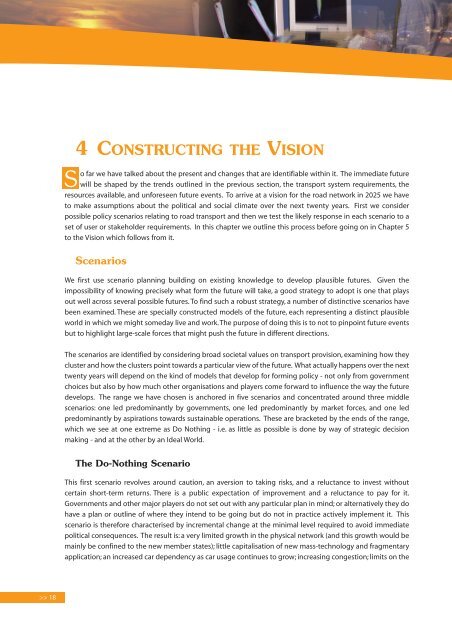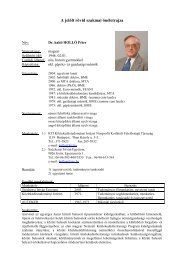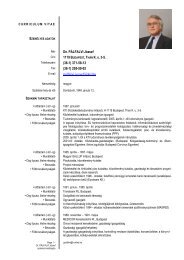VISION: Road Transport in Europe 2025 - FEHRL
VISION: Road Transport in Europe 2025 - FEHRL
VISION: Road Transport in Europe 2025 - FEHRL
Create successful ePaper yourself
Turn your PDF publications into a flip-book with our unique Google optimized e-Paper software.
18<br />
S o<br />
4CONSTRUCTING THE <strong>VISION</strong><br />
far we have talked about the present and changes that are identifiable with<strong>in</strong> it. The immediate future<br />
will be shaped by the trends outl<strong>in</strong>ed <strong>in</strong> the previous section, the transport system requirements, the<br />
resources available, and unforeseen future events. To arrive at a vision for the road network <strong>in</strong> <strong>2025</strong> we have<br />
to make assumptions about the political and social climate over the next twenty years. First we consider<br />
possible policy scenarios relat<strong>in</strong>g to road transport and then we test the likely response <strong>in</strong> each scenario to a<br />
set of user or stakeholder requirements. In this chapter we outl<strong>in</strong>e this process before go<strong>in</strong>g on <strong>in</strong> Chapter 5<br />
to the Vision which follows from it.<br />
Scenarios<br />
We first use scenario plann<strong>in</strong>g build<strong>in</strong>g on exist<strong>in</strong>g knowledge to develop plausible futures. Given the<br />
impossibility of know<strong>in</strong>g precisely what form the future will take, a good strategy to adopt is one that plays<br />
out well across several possible futures. To f<strong>in</strong>d such a robust strategy, a number of dist<strong>in</strong>ctive scenarios have<br />
been exam<strong>in</strong>ed. These are specially constructed models of the future, each represent<strong>in</strong>g a dist<strong>in</strong>ct plausible<br />
world <strong>in</strong> which we might someday live and work.The purpose of do<strong>in</strong>g this is to not to p<strong>in</strong>po<strong>in</strong>t future events<br />
but to highlight large-scale forces that might push the future <strong>in</strong> different directions.<br />
The scenarios are identified by consider<strong>in</strong>g broad societal values on transport provision, exam<strong>in</strong><strong>in</strong>g how they<br />
cluster and how the clusters po<strong>in</strong>t towards a particular view of the future. What actually happens over the next<br />
twenty years will depend on the k<strong>in</strong>d of models that develop for form<strong>in</strong>g policy - not only from government<br />
choices but also by how much other organisations and players come forward to <strong>in</strong>fluence the way the future<br />
develops. The range we have chosen is anchored <strong>in</strong> five scenarios and concentrated around three middle<br />
scenarios: one led predom<strong>in</strong>antly by governments, one led predom<strong>in</strong>antly by market forces, and one led<br />
predom<strong>in</strong>antly by aspirations towards susta<strong>in</strong>able operations. These are bracketed by the ends of the range,<br />
which we see at one extreme as Do Noth<strong>in</strong>g - i.e. as little as possible is done by way of strategic decision<br />
mak<strong>in</strong>g - and at the other by an Ideal World.<br />
The Do-Noth<strong>in</strong>g Scenario<br />
This first scenario revolves around caution, an aversion to tak<strong>in</strong>g risks, and a reluctance to <strong>in</strong>vest without<br />
certa<strong>in</strong> short-term returns. There is a public expectation of improvement and a reluctance to pay for it.<br />
Governments and other major players do not set out with any particular plan <strong>in</strong> m<strong>in</strong>d; or alternatively they do<br />
have a plan or outl<strong>in</strong>e of where they <strong>in</strong>tend to be go<strong>in</strong>g but do not <strong>in</strong> practice actively implement it. This<br />
scenario is therefore characterised by <strong>in</strong>cremental change at the m<strong>in</strong>imal level required to avoid immediate<br />
political consequences. The result is: a very limited growth <strong>in</strong> the physical network (and this growth would be<br />
ma<strong>in</strong>ly be conf<strong>in</strong>ed to the new member states); little capitalisation of new mass-technology and fragmentary<br />
application; an <strong>in</strong>creased car dependency as car usage cont<strong>in</strong>ues to grow; <strong>in</strong>creas<strong>in</strong>g congestion; limits on the






